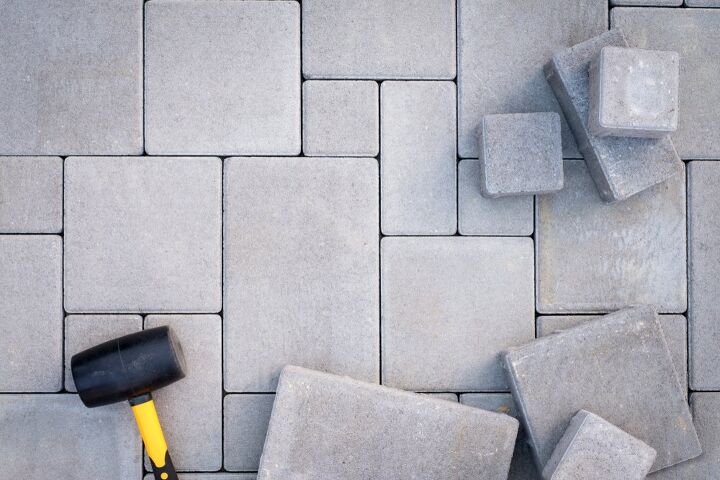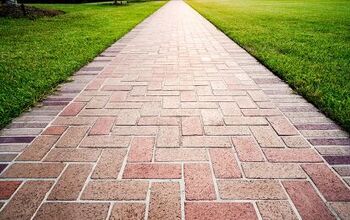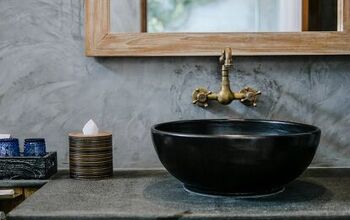Can You Stain Concrete Pavers? (Find Out Now!)

Changing up the look of your patio is a great way to liven up the outdoor area surrounding your home. You don’t even have to spend big to make significant changes. Focusing on elements such as your patio pavers can bring forth the changes you’re seeking.
So, what can you do alter the appearance of your concrete pavers? Is staining them an option for you to consider?
Staining concrete pavers is indeed an option and you will get great results if they haven’t been sealed yet. If they have been sealed already, you will first have to remove the sealer before applying the concrete stain. The stain itself can be easily applied if you have a paint roller and tray on hand.
Improving the dull and lifeless look of your concrete pavers is necessary if you want to transform your yard. Find out if staining those concrete pavers will help by reading on.
Do You Need Pavers for Driveway and Floors Installed?
Get free, zero-commitment quotes from pro contractors near you.

Can You Apply Concrete Stain on Your Concrete Pavers?
Elevating the look of your yard doesn’t necessarily mean paying for expensive new fixtures or making room for more plants. Working on the smaller elements of your yard can still make a huge difference.
For instance, changing the appearance of your concrete pavers is something worth considering if you’re going for a patio redesign. We’re not talking about carving or cutting your concrete pavers. Instead, you should think about altering their color.
Staining your concrete pavers is an option if you want to change how they look. The process of staining a concrete paver is not that complicated. However, there are certain factors that can prevent the stain from producing the intended result.
Already Stained Concrete Pavers
Are your concrete pavers already stained? If so, you may want to reconsider your plans to stain them again.
The problem with introducing an additional stain to already stained concrete pavers is that the final product will likely look off. You may not get the exact color you want because the new stain will just mix with the old one. The new stain may not even obscure the one already in place.
Sealed or Not Sealed
Before you start staining your concrete pavers, you should first check if they are sealed. The presence of the sealant will get in the way. Upon being applied, the stain will not look right because the sealant stopped it from being fully absorbed by the concrete.
The process of checking whether a concrete paver has been sealed is pretty easy. All you really need is a container with some water.
Pick up the container full of water and pour some of the liquid onto the concrete. Set the container down after pouring the water then check on the pavers.
If the concrete pavers have been sealed, a significant amount of the water you poured will stay on the surface. They may cluster into some beads because the concrete has not absorbed them.
If the concrete pavers have not been sealed, the water is likely going to be absorbed quickly. You will notice the concrete darken due to the addition of moisture.
Unsealed concrete pavers are great to work with from a staining standpoint. The stains will look great on them. However, homeowners who have sealed concrete pavers have more work to do before they can proceed to staining.
How to Remove the Concrete Sealer
The process of removing sealer from your concrete pavers is pretty straightforward. As long as you have the appropriate items, you should be able to pull it off.
Step 1: Determine What Kind of Concrete Sealer Has Been Used
In order to remove the sealer, you first have to know which type you’re dealing with. Two types of sealers are often used for concrete pavers. Those are solvent-based sealers and water-based sealers.
Get a solvent-based stripper and apply a small amount of that on to one of the pavers. Let it sit for about 30 seconds. After that, use your finger to check how the substance feels.
The concrete feeling sticky to the touch means a solvent-based sealer was used. A lack of stickiness tells you that the concrete was sealed by a water-based sealer.
Step 2: Get the Appropriate Sealer Remover
Now that you know what type of sealer was used, you can pick up the correct item to remove it. You may not have to make an additional purchase if a solvent-based sealer was used.
Step 3: Follow the Instructions for the Sealer Remover
The instructions for using sealer removers can vary slightly. You should follow what the manufacturer says so the sealer is properly stripped off.
How to Stain Your Concrete Pavers
Let’s now proceed to the process of staining your concrete pavers. The process itself is fairly simple and it’s a good DIY project to take on.
Step 1: Gather the Materials Needed
For this project, you’ll need a broom, a hose, a paint roller, a paint tray, concrete sealer, and the concrete stain. Account for how many pavers you’re working on when getting the sealer and stain.
Step 2: Clean the Concrete Pavers
Cleaning the concrete pavers will allow the stain to adhere to them better. This is a necessary step if you want the concrete pavers to look as good as possible.
Start by sweeping the surface of the concrete. You can then use the hose to dislodge as much debris as possible. If there are any stubborn weeds in the way, you should get rid of them too.
Wait for a while after spraying the concrete pavers. They should be nice and dry before staining.
Optional Step: Cover Concrete Pavers You Don’t Want to Stain
You may be trying to create a pattern using your concrete pavers. To do so properly, some pavers need to be colored while others need to stay the same.
Grab a tarp and use that to cover the concrete pavers that you don’t want to stain. If you’re targeting individual pavers, you may want to use small pieces of plastic or old newspapers to cover them.
Homeowners can also choose to create multi-colored pavers. You can do that by using painter’s tape to divide the paver into distinct portions. Cover one portion first while you work on the other side.
Step 3: Stain the Concrete Pavers
It’s now time to stain the concrete pavers. Start by pouring some of the concrete stain into the paint tray.
Next, take your roller and dip it into the tray. Let some of the excess stain drip back into the tray. That will make it easier to control the spread of the stain over the paver.
You can now go ahead and start rolling the stain onto the concrete surface. Work carefully to avoid staining a surface accidentally. Also make sure to cover as much of your target surface as possible.
Step 4: Apply Concrete Sealer
Once you’re happy with the new look of your concrete pavers, you can go ahead and apply the concrete sealer. This is not an optional step.
The sealer is crucial if you want to adequately protect your concrete pavers. Note that you may have to apply multiple coats of sealer to properly protect the concrete.
Do You Need Pavers for Driveway and Floors Installed?
Get free, zero-commitment quotes from pro contractors near you.

Related Questions
What Are the Different Types of Pavers?
Pavers can vary in terms of their material composition. They may be made from concrete, clay, brick, rubber, and even plastic.Homeowners who want the prettiest pavers may want to look at the natural stone pavers. Those items are typically made from bluestone, cobblestone, flagstone, granite, limestone, and travertine. The rustic look of natural stone pavers is also something that many homeowners find appealing.
Can You Pressure Wash Concrete Pavers?
Pressure washing your concrete pavers is not a good idea. The pressurized water can destroy the seal and leave the concrete exposed. The pavers will be cleaned, but they will become vulnerable too and you don’t want that.Aside from pressure washers, you should also avoid using acidic cleaners on your concrete pavers. The acidic cleaners can also damage the seal so it’s best to avoid them.
Related Guide

Gary Evans is passionate about home improvement. He loves finding out how to make improvements in the easiest, most practical, and most affordable ways. Upgrading his home kitchen is one of his ongoing hobbies. Gary is also a long-time content creator and enjoys spending his free time tending to his hydroponic vegetable garden.
More by Gary Evans



























